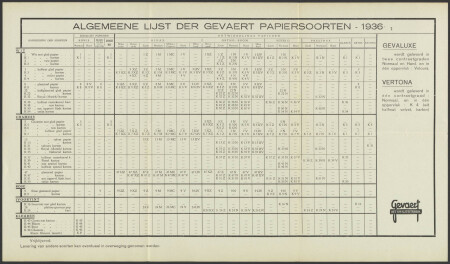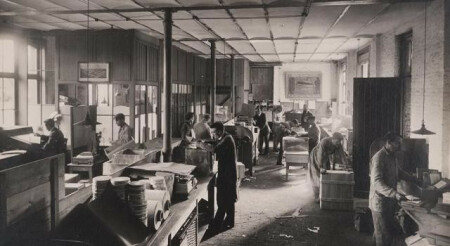The Gevaert Paper Project, unlocking a historical collection
The Photo Museum Antwerp (FOMU) is making the historical Agfa-Gevaert collection available in the Gevaert Paper Project. This will give the general public access to a wealth of photographic paper, photo documentation, packaging and sample books from the period 1894-1964. As a partner in this project, we are responsible for publishing the collection data as linked data (link in Dutch) to ensure new content can be linked to the FOMU collection and other similar collections worldwide.
Challenge
Black and white photography peaked in the 1930s. Its cultural impact and relevance, and the diversity of paper and number of manufacturers were all immense. Elements such as texture, gloss, colour and thickness make each paper unique and can teach us a lot about photographers’ technical and artistic working methods at the time. The paper also tells us more about the ways in which manufacturers managed photographers’ expectations. The successful L. Gevaert & Cie company from Antwerp was one of these manufacturers, and it merged with the German company Agfa AG in 1964.
In 2015, the Province of Antwerp took over this glorious photographic paper producer’s historical archive before joining forces with the Photo Museum (FOMU). Together, they wanted to find a way to re-purpose this company archive and so launched a preliminary process which then created momentum for further plans. This resulted in the Gevaert Paper Project: unlocking a reference collection of photographic paper, packaging and documentation, which started in 2020.
But the Agfa-Gevaert collection is very extensive, and making all the available content accessible would be out of scope for this project. It was therefore decided to focus on the photographic papers, packaging and documentation, which together amount to around 50 linear metres in total. FOMU also has its own collection of photographic packaging and sample books, adding around 2,550 further items.

Historisch Archief Agfa-Gevaert, Algemene lijst der Gevaert Papiersoorten, Collectie Fotomuseum Antwerpen, 001-GEV_0014_0006_img-044
Our role
As a partner in this project, our key role is to publish the collection data as linked data. The project is also helping us to develop two of our knowledge domains further, i.e. metadata and linked (open) data.
Preparation
We’re responsible for setting up a Wikibase during the test phase. This will allow us to build a shared knowledge base – an ideal starting point for linked open data. We’re also supporting the project by selecting a professional hosting service to help set up this Wikibase, and developing a metadata model in this phase. This model can register the Gevaert products and record them as the authority list (link in Dutch) in Wikibase.
Finally, we’re also supervising the drafting of the implementation protocol to address copyright clearance and provide documentation of any copyright restrictions.
Implementation
Following on from this preliminary phase, there are four implementation issues awaiting us:
data model
LOD publication (link in Dutch)
image management
unlocking
For the data model, we’re investigating the possibility of publishing the Gevaert graph as OSLO data (link in Dutch) and providing support to link it with external authorities and systems. These are descriptions in the Adlib and Axiell (link in Dutch) collection management systems, images in the ResourceSpace digital asset management system, the Art & Architecture Thesaurus (AAT), and others. We’re also publishing user documentation and recipes for re-using the Gevaert data via the SPARQL endpoint (link in Dutch). Specific items on the agenda include publishing recipes for visualisations of the collection and supporting the production of JSONLD datasets.
With regard to image management, we’re advising on the metadata model for images in ResourceSpace and the configuration of IIIF endpoint (link in Dutch). And we’ll be joining the focus group for the unlocking aspect.
Approach
The Gevaert Paper Project gives FOMU the opportunity to maximise the potential of open data in managing its large-scale archival collection. Given the scope of the project, FOMU is intending to tackle the (basic/extended) registration, preservation, digitisation and unlocking of networked content as (linked) open data in three consecutive phases.
The first phase consists of preliminary research and unlocking a test selection. It started in 2020 with support from the Flemish Government and will end in 2021. Following on from this thorough preparation, the implementation work will then take place in two subsequent phases.
Result of the project
When the project is complete, FOMU will be better able to respond to the many questions it receives from researchers and heritage professionals. The project will also enable continued research into the management of extensive photographic resources in a museum context, and develop methodologies for sharing them with the sector. FOMU is therefore contributing to the preservation and management of this analogue heritage.
Partners
FOMU is running this project in close collaboration with meemoo. Other partners are:
Paul Messier and the IPCH Lens Media Lab from Yale University;
Elena Bulat from the Weissman Preservation Center at Harvard Library.

